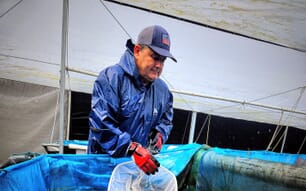Identity
Eriocheir sinensis H. Milne Edwards, 1853 [Grapsidae]
FAO Names: En - Chinese mitten crab, Fr - Crabe chinois, Es - Cangrejo chino
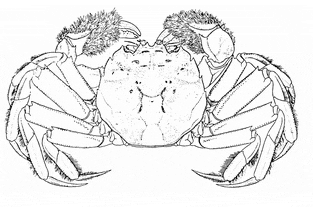
Biological features
Square shaped carapace, a little longer than wide, markedly convex and uneven, bearing four sharply edged epigastric lobes. Propodus of the fifth pereiopod rather narrow and slender with dactylus claw-shaped. Males produce an intensive mitten-like covering on the claws, with hairs both at inner and outer surfaces or only at the outer surface (always naked and smooth in other Eriocheir species). No longitudinal row of hairs on dorsal part of propodus in the anterior two pairs of ambulatory legs. Front with four acuminated and deeply separated teeth. Four anterolateral tooth distinct (not rudimentary).
View SIDP Species fact sheet
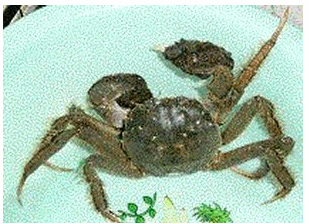
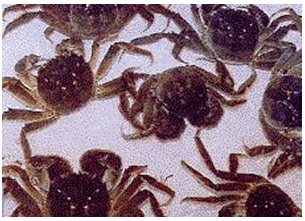
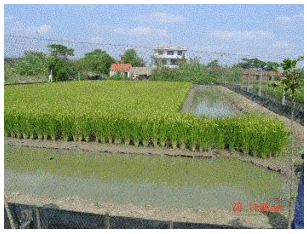
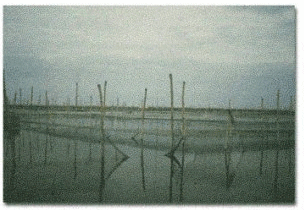
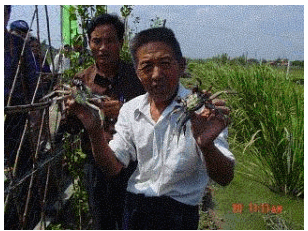
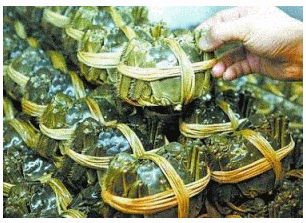
Profile
Historical background
Chinese river crab is a rather recent entry as an aquaculture species, the first farmed production being reported to FAO in 1989. Its culture evolved from the release of collected natural crab seed into lakes that had been isolated from rivers by water-gates in Jiangsu province of China in the late 1970s, a form of fisheries enhancement. True aquaculture of this species began in small lakes in the lower reaches of the Yangtze River and is characterized by the stocking either of artificially propagated seed or wild seed, together with supplementary feeding. The farming of Chinese river crab expanded very rapidly since the 1990s in China and has been gradually introduced to various aquaculture environments, namely earthen ponds, pens in shallow lakes, and paddy fields, etc. Chinese river crab farming is now an important component of the freshwater aquaculture industry in China. The Republic of Korea is the only other country that reports cultured Chinese river crab production. There have also been reports on the experimental culture of this species in Germany and the US (California) by local Chinese people.

Habitat and biology
This crab originates from the temperate waters between East Russia (Vladivostok) to South China, the Korean Peninsular, Japan and Taiwan Province of China. It has been transferred, probably in ballast waters to northern Europe in 1900s and appears to have established self-reproducing populations there. It has more recently been found in North America and Hawaii. Chinese river crabs live in inland water bodies connected to estuaries until they reach sexual maturity, after which they normally migrate downstream to brackishwater estuarine areas to reproduce. This migration usually starts in October. Both male and female crabs usually die after completing reproduction. The crab usually prefers troglodytism or hiding in aquatic weeds or sands and gravels. The crabs normally hide in their shelters during the daytime and move out for feeding during the night. The species is omnivorous, feeding on prawns, small fish, benthic animals and tender macrophytes. Mature crabs are normally 100–200 g but crabs of 400–500 g have also been reported.
Production
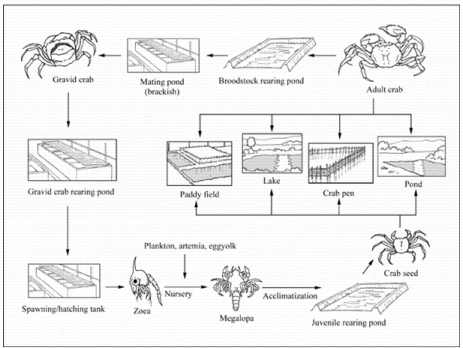
Various production systems are currently used for the grow-out of Chinese river crabs. Net-pens installed in shallow lakes, earthen ponds, paddy fields, and small lakes and reservoirs are the most common systems employed for grow-out, while earthen ponds and paddy fields are commonly used for seed rearing of the crab.
Seed of Chinese river crabs (megalopa) used to be abundant in the rivers connected to the Yellow Sea. However, this natural resource has become drastically depleted since the late 1980s, due to over fishing and changes in the environment. Presently, the crab seeds used for aquaculture are principally from artificial propagation. Broodstock crabs are selected from adult crabs that are reared in ponds, pens or natural waterbodies. Seawater or artificial saline water is used for the propagation and larval rearing.
Healthy well-grown adult crabs from crab pens or open water bodies (lakes/reservoirs) are selected as broodstock in October and restocked for intensive rearing to ensure good gonad development; male and female crabs are stocked in different ponds. Male and female brooder crabs are transferred at a female:male ratio of 2 3:1 to mating tanks filled with saline water (7–33‰) in the following spring (late February–early March). Male crabs are removed after mating is completed (usually after two weeks). Gravid females are reared for about one month under intensive care before the eggs hatch. Sufficient feeding (more animal food) and constant salinity are very important throughout the rearing period, and also in the egg hatching process.
About two days before the eggs hatch (the eggs become transparent and the eyespot and heartbeat become visible), gravid crabs are transferred to a larval rearing tank, usually at three crabs/m³. The density of the newly hatched crab larvae (zoea) is controlled at 200 000–300 000/m³. The gravid crabs are transferred to another tank once this density is attained. Larval rearing takes about three weeks, during which the zoea moult five times to reach the megalopa stage.
Salinity is reduced gradually to almost freshwater when the megalopa are two–three days old. Feed types include microalgae, zooplankton, egg yolk and Artemia nauplii and adults; frequent and adequate feeding is vitally important for high survival rate and good larval growth and to minimize cannibalism. Aeration and good water quality is also essential. The optimal water temperature is 22–25 °C. Normally a production of 50 000–100 000 megalopa/m³ is achievable. Megalopa that are more than five days old are ready for stocking in seed crab rearing pond (nursery).
Megalopa need to be reared to 5–20 g before grow-out; both earthen ponds and paddy fields can be used as nurseries.
Single-stage nursery system
Earthen ponds, usually 350–1 320 m² in area, are commonly used for rearing crab seeds and normally stocked at 130–150/m² in shallow water (~50 cm). The water depth is gradually increased to 1–1.2 m by mid-summer and maintained at that level afterwards. In the early stages (up to the 3rd moult), the crab feeds mainly on natural food obtained by organic fertilization. Supplementary feeds, such as soybean milk and paste form feeds (wheat bran, soybean cake, rice bran, etc.) are also used. After this period, the crabs are called stage III juveniles and become bottom feeders; both plant (tender aquatic weeds, terrestrial grasses, pumpkin, various grains and their by-products) and animal feeds (mainly crushed freshwater molluscs and low quality fish) can be fed; the proportion of animal feed should be 20–30 percent of the total but is increased to 40 percent when water temperatures decline in late autumn.
Plastic sheet fences are needed to prevent crabs from escaping. The pond bottom should be sloped to provide much shallower water along the dike facing the sun. Aquatic weeds are planted to cover one third of the pond bottom. Good water quality and predator control are essential. Normally, 1 200 kg/ha of crab seed (size 10–15 g each) can be produced.
Two-stage nursery system
Another method used for crab seed rearing is to rear the megalopa intensively in either cement tanks at 30 000–60 000/m², or 6 000–10 000/m² in fine-mesh cages, or 1 500–3 000/m² in earthen ponds until they become stage III juveniles; this usually takes 20–25 days. The crabs are fed with a paste made of soybean cake, peanut cake and wheat bran, large zooplankton, blood meal and tender aquatic weeds. After they become stage III juveniles they are transferred to earthen ponds or paddy fields at 40/m² in earthen ponds for further rearing.
Paddy fields
When paddy fields are used for rearing crab seed, peripheral and crisscrossed trenches need to be dug; these should be 50 cm deep and 50–60 cm wide. Aquatic weeds need to be planted in the trenches to provide shelter. Plastic sheet fences prevent crab escape. In this system the stocking density of megalopa is 70–140/m². Other managerial aspects are similar to pond rearing.
The most commonly adopted systems for ongrowing are semi-intensive culture in ponds and net-pens and extensive culture in paddy fields and small lakes/reservoirs.
Semi-intensive culture in ponds
Ponds used for ongrowing Chinese river crabs are usually 0.15–0.35 ha and 1.5–2 m deep. Aquatic weeds are planted in shallow areas of the ponds to provide shelter for moulting crabs and plastic sheet fencing is used to prevent crab escape. 5–10 g crabs are stocked at 22 500–37 500/m², usually in early spring. It is common practice to stock about 3 000 silver carp and bighead carp (usually at a 7:3 ratio) and 1 500 crucian carp as well in order to utilize natural food and control water quality. The feeds used include both plant (aquatic weeds, pumpkin, vegetables, soybean cake, peanut cake, rapeseed cake, barley, corn, wheat bran, etc.) and animal feed ingredients (small fish, prawns, crushed freshwater molluscs, slaughterhouse waste, silkworm pupae, fish meal, earthworms and other aquatic invertebrates). Feeding rate depends on water temperature and is begun when it reaches 10 °C. Special care should be taken to the crab during moulting, especially to maintain good water quality and eliminate harmful animals. Crabs usually reach marketable size (125–200 g) by the end of autumn.
Semi-intensive culture in net-pens
Pen culture of Chinese river crabs is commonly practiced in shallow lakes and reservoirs. The bottom part of the pens is buried into the bottom soil, while the upper edge is about 0.8 m above the water surface and is extended inwards by a horizontal net. Crab pens are normally 2–20 ha and are normally stocked at the same time those in ponds. However, the stocking size is larger (between 10–15 g) and density is lower (usually 10 000–15 000/ha). Feeding and other management aspects are similar to pond culture. Due to good water quality, the large stocking size and relatively lower stocking density, crabs harvested from pens are larger than from ponds and paddy fields (150–200 g). They also usually fetch much high market prices, due to their larger size and superior quality.
Extensive culture in paddy fields
Rearing Chinese river crabs in paddy fields is another common practice; it is an ecologically friendly approach, being integrated agro-aquaculture and of benefit to both crabs and rice. The modification of paddy fields for crab ongrowing is the same as in seed production. Due to the short culture period, much lower stocking densities are used (7–20 g crabs at 6 000–9 000/ha); this results in a relatively large product size. Stocking usually occurs several days after the rice seedlings are transplanted. If the crabs are stocked first it is very important to keep them in the trenches during rice transplantation; otherwise, heavy losses of crab seed might occur. Crabs rely more on natural food in paddy fields than in pond and pen culture. However, supplementary feeding is still needed in the fast growing season; the feeds used are similar to those in pond and pen culture but the quantity is much reduced. The most important management aspect is to control in use of pesticides; their use cannot be entirely avoided throughout the rice growing period, so it essential to carefully select the types of pesticides and chemicals, the methods of application, and the times of application. It is also very important to prevent crabs escaping from paddy fields during their water management. With good management, 7 500 kg/ha of rice and 450–750 kg/ha of crabs can be harvested from this rearing system, bringing a net income of USD 1 800–3 000/ha.
Extensive culture in lakes and reservoirs
This form of culture can achieve very high economic benefits. The major criteria in selecting suitable water bodies include selecting a size that is manageable (from the point of view of controlling fishing activities and to prevent escapes of cultured crabs), abundant aquatic weeds and benthic animals, and relatively shallow water. Stocking is usually carried out in early spring; the density various greatly according to the specific size of the water body and the abundance of natural food but usually ranges from 200–600/ha. Stocking size varies according to the availability and cost of seed. Supplementary feed is usually applied only when there is insufficient natural food supply. Fishing activities need to be managed carefully (especially bottom fishing gears) to avoid damage to the crabs. All outlets and inlets need to be blocked with fencing materials to prevent crab escape. Production from this form of crab culture usually ranges between 5–30 kg/ha.
The use of feed has been discussed in the previous sub-sections of this fact sheet.
Crabs reared in ponds are harvested by traps, gillnets, light attraction, current induction, etc. Those reared in net-pens are usually caught in traps during October and November. In paddy field culture, crabs are harvested by trap or manually, usually one month after the rice has been harvested. Harvesting of the crabs reared in lakes and reservoirs, mainly by trapping, must be completed before the migrating season.
Harvested crabs are often kept in temporary holding tanks before marketing. They are usually transported in straw bags that are kept moist during transportation. Sometimes, the legs and claws are tied to reduce crab movement. Ice-bags are sometimes used to maintain a low temperature and a low mortality rate during transportation.
Some attempts are being made to process crabs. 'Drunken crab' (crab preserved in special sauce of high alcohol content) and a crystallized powder made from crab (used in cooking as a seasoning) are the two major commercially processed products now.
Production costs vary greatly, according to the production system and input level. Comparatively, production costs in semi-intensive culture in ponds and pens are relatively higher while those in extensive culture in lakes and reservoirs are the lowest. Crab culture in paddy fields is intermediate.
Diseases and control measures
Despite of the short history of development, disease problems have already become an important factor affecting the production and economic return of Chinese river crab culture. Major diseases commonly found in the culture of the crab and their diagnostic feature and treatment are show in the following table.
| DISEASE | AGENT | TYPE | SYNDROME | MEASURES |
|---|---|---|---|---|
| Shiver disease | Single-chain RNA virus; rickettsia like organisms | Virus and bacteria | Limbs convulsively shiver or are paralysed; slow movement; decreased response to external stimuli; ceases feeding and becomes inanimate; blackish, greyish or whitish gills; reddish muscle; liver-pancreas become rotten and smelly | Prevention: complete pond disinfection; remove excessive silt; plant aquatic weeds; maintain good water quality and balanced nutrition Treatment: none effective |
| Vibriosis | Vibrio anguillarum; V. alginolyticus;V. parahaemolyticus | Bacteria | Rotten abdomen and limbs; body discoloration; whitish lumps formed inside body tissues (especially gills); weakened body and reduced mobility; reduced or no feeding; becomes inanimate | Prevention: use reasonable stocking density, careful handling and maintenance of good water quality; disinfect nursery tank thoroughly with 15–20 ppm KMnO4 solution; dip nursery tools in 50 ppm bleaching powder solution for 1 hr; sterilize freshwater for preparing brackishwater with 10 ppm bleaching powder solution; dose ponds with 1 ppm terramycin Treatment: dose ponds with 2–3 mg/litre terramycin or 1 mg/litre norfloxacin once a day for 3–5 days; use medicated feed with terramycin (0.1–0.2 g/kg of body weight) for 1–2 periods each of 7 days duration |
| Sessilinasis | Zoothamnium spp.; Vorticella spp.; Epistylis spp.; Carchesium spp.; Intranstylum spp. | Parasites | Parasites become attached all over body, limb joints and gills; reduced feeding; difficulty in breathing; reduced normal movement; difficulty in moulting and slippery feel to body and limbs | Prevention: use reasonable stocking density; bathe gravid crabs with 10 ppm benzalkonium bromide for 30–50 min. before stocking in hatching tank; dose tanks with 10 mg/litre tea seed cake, replacing half of the water 12 hrs after application Treatment: dose tank with 5–10 mg/litre formalin or 0.7 ppm of a 5:2 mixture of CuSO4 and FeSO4; kill parasites on crab zoea I–II with 50 mg/litre formalin or 30 mg/litre benzalkonium bromide; bathe with 300 ppm benzalkonium bromide for 30–40 min or 500 ppm formalin for 40 min. |
| Shell ulcer disease | Vibrio sp.; Pseudomonas sp.; Aeromonas sp.; Spirillum sp.; Flavobacterium sp. | Bacteria | Damaged limb extremities and black ulcer, spreading to every limb segment and central dorsal area; whitish spot on thoracic plate, sunken at its centre and turning to dark-brown ulcer; skin-membrane and muscle visible through rotten holes in shell | Prevention: careful handling; well-balanced nutrition; avoid heavy metal pollution; dose ponds with 15–20 ppm quicklime; maintain good water quality and reasonable depth of bottom silt (5–10 cm) Treatment: dose pond with 2 ppm bleaching powder and use medicated feed (sulfonamides at 0.1–0.2 per cent of feed) for 3–5 days; dose pond with 2.5–3 ppm terramycin once a day for 5–7 days; use medicated feed (0.05–0.1 per cent terramycin) for 1–2 weeks |
| Black gill disease | Unidentified bacteria | Bacteria | Gill filaments dark brown at first, turning completely black; slow movement; difficulty in breathing | Prevention: keep suitable depth of bottom silt (5–10 cm); dose ponds with 15–20 mg/litre quicklime once every 15 days during the major epidemic season; regularly add new water to ponds to maintain good water quality Treatment: dose ponds twice with 15–20 mg/litre quicklime |
| Sacculina disease | Sacculina sp. | Parasitic barnacle | Parasite found on ventral side or limbs; part of parasite penetrates into body; part remains outside host and forms spore structure attached by stem to crab abdomen | Prevention: treat pond with 10 ppm bleaching powder or 5 ppm dipterex or 100 ppm formalin and remove excessive bottom silt before stocking; avoid using infected crab seed for stocking; stock some common carp to control the parasite Treatment: reduce salinity below 1‰ or transfer crabs to freshwater; bathe crabs with 8 ppm copper sulphate or 20 ppm KMnO4 for 10–20 minutes; dose pond with 0.7 ppm of a 5:2 mixture of CuSO4 and FeSO4 |
Suppliers of pathology expertise
Assistance on Chinese river crab health can be obtained from:
- Research Institute of Hydrobiology, CAS, 7# Southern East Lake Rd., Wuchang, Wuhan City, Hubei province, 430072 China.
- Shanghai Fisheries University, 334# Jungong Road, Shanghai, 200090 China.
- Freshwater Fisheries Research Centre, CAFS, 9# Eastern Shanshui Road, Wuxi, Jiangsu Province, 214081 China.
- Jiangsu Provincial Freshwater Fisheries Research Institute, 79# East Chating Road, Nanjing, Jiangsu Province, 210017 China.
- Zhejiang Provincial Freshwater Fisheries Research Institute, Nanmenwei, Huzhou City, Zhejiang Province, 313001 China.
Statistics
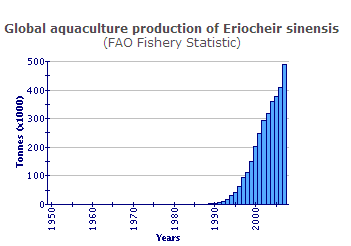
Although only two countries (China and the Republic of Korea) report farmed production of Chinese river crab to FAO, some production is know to occur in a number of other countries, mainly in northern Europe.
The first reported production of cultured Chinese river crab was from China in 1989 (3 305 tonnes). Rapid expansion has occurred, reaching over 368 000 tonnes in 2003, and an unofficial level of nearly 416 000 tonnes in 2004. Production in the Republic of Korea is, by comparison, small and variable; first reported in 1994 (3 tonnes), it has never yet exceeded its peak of 31 tonnes in 1997.
Market and trade
Almost all the commercial production of Chinese river crabs occurs in China itself. The product is locally consumed and generally marketed live, although processed products are emerging. The Chinese river crab used to be a rather high priced commodity but it has become more affordable to ordinary consumers in recent years. Chinese river crab are marketed at a fairly large range of prices (USD 5–25/kg) according to the size and environments where the crab is produced.
In 2004, China exported about 800 tonnes of live Chinese river crab, which were valued nearly USD 6 million, according to national statistical data. Exports increased by more than 70 per cent compared with 2003. Actual exports may be even greater, because China also report exports of some 7 000 tonnes of unspecified crab products. The major export markets are in Hong Kong SAR of China, Japan and the Republic of Korea.
Status and trends
Chinese river crab used to be an important wild caught aquatic product. It is favoured by consumers in China and some other Asian countries. Depleted natural production and increasing market demand played an important role in the rapid expansion of farmed mitten crabs since the late 1980s. Its culture is also promoted by the Chinese government as part of its efforts to diversify aquaculture species. Success in the artificial propagation of this species with natural and artificial saline water has provided the most important stimulus for expansion.
Due to the strong adaptability of the species to various small-scale farming practices, Chinese river crab culture is now contributing significantly to the income of rural farmers in many areas of China. Due to its relatively short history of development, its farming is still far from technical or managerial perfection. Currently, major achievements are being made on artificial propagation and seed rearing techniques and on special feed additives that can enhance the moulting process of the crab. Progress on nutrition, feed and optimal farming models is rather limited, however. This causes great variation in production levels, size of product, survival rate and economic efficiency. More effort is needed to further improve culture technology, in order to improve production efficiency and economic returns.
It takes time for the market to digest the rapid increase in production, although consumer demand is increasing steadily. The expansion of growth should be decelerated to ensure a reasonable market price and economic return for farmers.
Major efforts are needed to improve product quality and production efficiency. Expansion in the international trade in Chinese river crabs is expected, as they are becoming more popular in other countries. However, expansion is not expected to be rapid; for the moment most crabs will still be marketed locally.
Main issues
Chinese river crab culture has several advantages that have contributed to its rapid development in China. It has contributed significantly to inland aquaculture and rural development in the recent years. However, rapid expansion brings some problems with it that may affect further development. The major issues include the following:
- Artificial propagation and cross boundary movements of broodstock and seeds has had a serious impact on the biodiversity and germplasm resources.
- Crossbreeding of various local strains has contaminated the germplasm of the natural population. It is now difficult to find pure strains in different river systems; for example the Yangtze River strain that is recognized as the best strain for culture.
- Degradation in seed quality is another issue that attracts wide concern. Slow growth and early maturation are common problems that affect production and product quality.
- Unreasonably low market prices of cultured crabs have seriously affected the enthusiasm of farmers.
These issues need to be addressed effectively to ensure sustainable development.
Responsible aquaculture practices
Responsible aquaculture at the production level should be practised in accordance with the main principles of environmental and ecological protection – see Article 9 of the FAO Code of Conduct for Responsible Fisheries .
Several specific issues need to be addressed referring to Chinese river crab. For example, integrated crab-rice farming should be strongly encouraged. Among all culture systems for this species, integrated crab-rice farming is the most ecological approach. It is also a relatively low input-high output production system that can be adopted by small rural rice farmers. It requires very little additional natural resources. Recent government policy changes that reemphasize the importance of grain production is a good driving force; farmers will get special subsidy for growing rice. This will encourage those who abandoned rice plantation to resume integrated crab-rice farming practice again.
It is also important to have better control over the quality of crab seed production, especially in the selection of broodstock for hatchery operations. A selective breeding programme should be carried to ensure the genetic quality of the Chinese river crab. High quality crab seed could significantly improve production performance, and resistance to disease and environmental stress. It could also lead to reduced use of chemicals and drugs in the farming of this species and improve the quality of its products. In addition, well control breeding activities could also minimize the impact of artificially produced seed on the natural crab population.
Pen culture in shallow lakes and reservoirs produces high quality crab products. However, it can cause adverse environmental impacts if it is not well planned. Heavy deposition of feeds and other materials into the crab pens can deteriorate water quality and cause other environmental degradation. The total area and distribution of crab pens in each specific water body should be carefully controlled to minimize adverse environmental impacts.
When extensive Chinese river crab culture is conducted in natural water bodies, the population density should be well controlled too. This species is quite destructive to macrophytes; the natural resource of aquatic weeds can be seriously damaged and may be difficult to recover if the crab population biomass is too high.
February 2010




